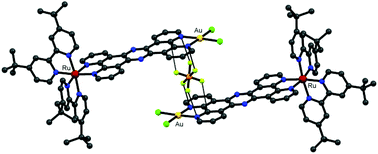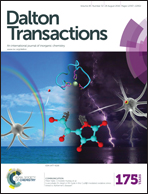π-Stacking attraction vs. electrostatic repulsion: competing supramolecular interactions in a tpphz-bridged Ru(ii)/Au(iii) complex†
Abstract
The synthesis and characterization of a mixed metal ruthenium(II)/gold(III) complex bridged by tetrapyridophenazine (tpphz) are described. It is isostructural and isoelectronic to the well-known photocatalysts with palladium(II) or platinum(II). Concentration dependent 1H-NMR spectroscopy and XRD studies show that the electrostatic repulsion between the gold(III) moieties exceeds the attractive π-stacking interaction. Theoretical calculations based on the new structural data confirm an increased positive charge on the bridging ligand as well as significantly altered orbital symmetry as compared to the previously investigated palladium(II) complex. This is the first example of a tpphz ruthenium(II) complex where π-stacking is completely inhibited. The detailed investigation of the solid-state structure showed for the first time in bimetallic tpphz bridged complexes no significant torsion within the bridging ligand itself. Although catalytic performance for proton reduction by gold(III) is naturally not observed, its photochemical decomposition in colloidal gold particles could be shown by TEM and DLS.


 Please wait while we load your content...
Please wait while we load your content...